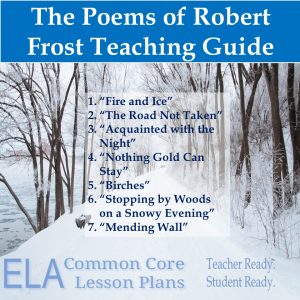Teacher’s Guide to Poems by Robert Frost
Use these poems by Robert Frost to teach the elements of poetry, critical thinking, and reading comprehension. It contains Robert Frost teaching activities, Robert Frost lesson plans and links to Robert Frost poems.
Frost Bitten
I felt great. I had just taught an amazing lesson on annotating poems. Students gave me high-fives as they walked out the door. Finally, they would be writing intelligent analysis in their poetry essaysMy joy turned to horror as I read “This poem was awesome” 4,789 times. I cried, as stunned students snickered at my suffering. Seconds before peppering the class with heavy duty 24-gauge staples, I had an idea: maybe I should come up with a list of poems by Robert Frost with Robert Frost teaching activities instead. I put the stapler away, called my psychic, and cancelled my free consultation.
I had work to do. I had to create a list of poems by Robert Frost with Robert Frost teaching activities. Here’s what I came up with.
I’m gonna give you something right now that you can use in your classroom immediately: Symbolism in the Poems of Robert Frost Lesson Plan.
Lesson Ideas for Robert Frost Poetry
-
“Fire and Ice”: Frost ponders whether the world will end by fire or ice. It’s jovial rhythm belies the somber message–the dangers of desire and hatred. The poem is a study in contrast. Use a Venn diagram to compare desire and hate. This Poem makes an excellent candidate for analysis and annotation.
- “Acquainted with the Night”: Many of Frost’s poems include night and its symbolic ramifications, the obvious one being death. This poem also presents several examples of hyperbole. Make a two-column chart. In the left column list examples of hyperbole. In the right column comment on why Frost chooses this specific hyperbole. Follow this link for an excellent “Acquainted with the Night” lesson plan.
- “Mending Wall”: Frost describes the annual mending of his wall. Think metaphor. Think good “Mending Wall” lesson plan. Think brainstorming activity: (1) list the purposes for walls; (2) list things that divide humans.
- “Stopping by Woods on a Snowy Evening”: Something tells me this poem is more than just stopping by woods on a snowy evening. Symbols abound. It makes an excellent poem for teaching mood: (1) Write “mood” on the board; (2) Write down several moods that may apply–lonely, creepy, dark, ominous, silent; (3) list key words that contribute to the mood. Focus on the rhyme scheme. Each stanza is connected to the next. Why? Is it the futility of trying to escape the past or the futility of trying to escape death? Have your students annotate this poem. You’ll be pleasantly surprised.
- “Nothing Gold Can Stay”: Students familiar with The Outsiders will recognize Frost’s pessimistic poem on the destiny of mankind, claiming that the world was created in its perfect form and has since deteriorated.
- “The Road Not Taken”: Easily Frost’s most famous poems, it holds many meanings to many people. The poem is about choices.
- “Birches”: Frost reminisces about the wonders of youth.
There’s an update to this page. Just click.
ELA Common Core Standards Covered
Teaching poems by Robert Frost covers the following ELA Common Core Standards. This is for your administrator, not your kids. Kids need student-friendly worded objectives.
- RL.9-10.1 Cite strong and thorough textual evidence to support analysis of what the text says explicitly as well as inferences drawn from the text
- RL.9-10.10 By the end of grade 9, read and comprehend literature, including stories, dramas, and poems, in the grades 9-10 text complexity band proficiently, with scaffolding as needed at the high end of the range. By the end of grade 10, read and comprehend literature, including stories, dramas, and poems, at the high end of the grades 9-10 text complexity band independently and proficiently.
- L.9-10.5 Demonstrate understanding of figurative language, word relationships, and nuances in word meanings.
- L.9-10.5a Interpret figures of speech (e.g., euphemism, oxymoron) in context and analyze their role in the text.
- Common Core Writing Standard 1. Write arguments to support claims in an analysis of substantive topics or texts, using valid reasoning and relevant and sufficient evidence.
- Common Core Writing Standard 2. Write informative/explanatory texts to examine and convey complex ideas, concepts, and information clearly and accurately through the effective selection, organization, and analysis of content.
Teaching the Common Core Standards by Teaching Poetry Masters
Just because someone came up with a fancy set of standards doesn’t mean you can’t teach your favorite poets.
- Teaching the Poems of Emily Dickinson
- Teaching the Poems of Langston Hughes
- Teaching the Poems of Walt Whitman
- Teaching the Poems of Shel Silverstein
- Teaching the Poems of Carl Sandburg
- Teaching the Poems of Robert Frost
Last Updated on April 22, 2016 by Trenton Lorcher


